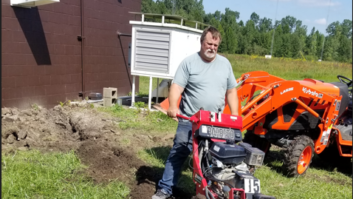Photos
(click thumbnail)Fig. 1: This type of regulator mounts your gauge assembly to the wall.
(click thumbnail)Fig. 2: Use a quick-release webbed belt to secure nitrogen tanks.
(click thumbnail)Fig. 3: Desire for ample workspace drove the layout of this Nassau studio in New Hampshire.
(click thumbnail)Fig. 4: Black plastic jackets help organize a multitude of monitor cables.
(click thumbnail)Fig. 5: For safety’s sake, install 911 address signs at your transmitter site.When was the last time you checked your nitrogen regulator assembly? As we pointed out in the Aug. 2 Workbench, these assemblies can leak, depleting a nitrogen tank in no time.
Where should you shop for a replacement? If you haven’t visited a welding supply or bottled gas store, pay a visit. Usually the company from which you rent the bottled nitrogen will have a retail store associated with it.
You’ll be amazed at the assortment of gas-related accessories that can make your life easier and safer. What will you find? One is the regulator assembly shown in Fig. 1, submitted by Contract Engineer Bryan Hars of Hilltop Engineering.
Unlike traditional assemblies, this is designed to mount permanently on the wall, with a jacketed connecting hose running to the tank. There’s less chance that the gauges could be dropped or damaged when removing a tank, because the gauges are secured. Only the flexible hose gets moved.
Pro Star manufactures the tank bracket assembly shown in Fig. 2. This bracket also mounts to the wall; webbed belts are used to secure the tanks.
These accessories are affordable and will help you perform your job more efficiently.
* * *
Ask Nassau New Hampshire’s Engineering Manager Dirk Nadon what he and his staff have been up to and he’ll tell you “Studios!”
A view of a new air studio in Hooksett, N.H., is shown in Fig. 3. Note the flat-screen monitor for the hard-drive system, clear copy stand for host/co-host interaction and emergency lights up on the soundproofed wall. There’s also plenty of workspace for air staff.
Fig. 4 shows one of the many finishing touches: cables concealed by a flexible plastic jacket that reduces clutter and keeps the studio tabletop clean and neat. The jacket also makes cable identification easier should a monitor need to be replaced. Cost? Less than $5 for a roll of plastic jacket found at electronic supply stores, even RadioShack.
* * *
Kevin Larke is market chief for four FMs that make up the Holt, Mich., cluster of the Mid-Michigan Radio Group.
Recently, Kevin’s 94.1 WVIC site lost power after a thunderstorm. It happened around 10 p.m., and the station continued on the air with the generator. Kevin reported the outage to the utility company, Consumers Energy, which gave an estimated restoration time of 6 a.m.
The next morning, Kevin noticed the station was still on generator (he has the transfer switch wired to the Burk Remote Control status inputs to save him a trip to each of the sites). He drove to the site with 20 gallons of diesel fuel in 5-gallon cans to add to the tank.
At 10 a.m., a Consumers Energy truck passed slowly on the road and Kevin chased it down. It turns out the crew was still trying to find the station address. The utility had the power back on by 10:30.
The location is difficult, because the entrance is through someone’s yard. The Consumers foreman told Kevin that a truck had come by at 2:30 a.m. but couldn’t find the station driveway and left.
Kevin had given the customer service representative a description of the driveway and noted a 2-by-3-foot white sign with the station call letters and tower registration number listed. Kevin had also provided his cell phone number and said they could call anytime. None of this was entered in the work order; the repair crew had only a street address. The utility foreman recommended putting up the address number by the homeowner’s driveway using standard 911 signage.
A good idea. Kevin bought a couple of the green reflective “911” address sign kits at a hardware store for $18 each. The kit includes a 6-by-18-inch aluminum sign and a bunch of 3-inch white reflective numbers. All you supply are the mounting pole and hardware. If your hardware store doesn’t stock these signs, Kevin says kits are available on the Internet for $20 plus shipping.
Kevin mounted these signs on 6-foot steel “T” posts that cost $3.50 each. He knocked the posts into the ground with a big hammer. (Do this before bolting the signs on, Kevin says; you won’t want to miss and smash your spiffy new signs.)
The signs will make it easier for telephone and power companies to find his sites. Kevin’s assistant engineer, Drew Henderson, also had a good point: If the staff ever needs to call 911, the signage will make it easier for responders to find the transmitter locations. Twenty-five dollars is pretty cheap for a safety aid that could get you back on the air or even save your life.

















